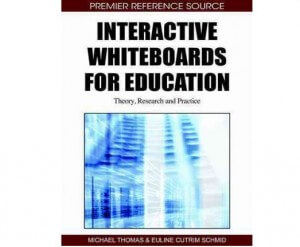To what extent is there a divide between the world of academia and the world of the language classroom?
Well, as an RSA trained-teacher with a Diploma, I embarked on an Masters. I went to a (fantastic) conference about computers in language teaching in Barcelona where I first met the Dude (aka Gavin) & saw on the programme the following names: Mark Warschauer, Catherine Doughty, Carol Chapelle, Martha Pennington. I picked up my Bibliography for the Masters and anyone who was anyone in the booklist was at this conference! Holy schmolly. In the hallowed world of CALL, theory, research and SLA, these were mythical figures.As a teacher, I never heard of any of them.
 Now we have our practitioners book out there, (400 ideas, in case anyone has forgotten), I am spending this Christmas reading Interactive whiteboards for education: theory, research and practice, Edited by Michael Thomas M. & Eulin-Cutrim Schmid (2010). A mere 314 pages, heavier than a door-stop.
Now we have our practitioners book out there, (400 ideas, in case anyone has forgotten), I am spending this Christmas reading Interactive whiteboards for education: theory, research and practice, Edited by Michael Thomas M. & Eulin-Cutrim Schmid (2010). A mere 314 pages, heavier than a door-stop.
I’m preparing for running a session for the Research group at Warwick University, and for the Pro-T conference in Argentina. I’m delighted to consider the link between theory and practice. Like great contrarians, I have decided to work backwards from what we do in real life to what the research shows. Tee hee. After all, wikipedia could never exist in theory…………
Interactive whiteboards for education: theory, research and practice, Edited by Michael Thomas M. & Eulin-Cutrim Schmid (2010), published by Hershey, PA (USA): IGI Global. ISBN: 978-1-61520-715-2.

I might get this book too. As you say, it can also prop open doors so it’s truly interactive! There are so many fantastic ways now to encourage students to engage and interact with their learning, it’s hard to know which to pick. But, if teachers think back to the best and most successful lessons they taught, they’ll remember it was the times when students interacted with the material even if it meant a lot of spin-offs on tangents. That’s how you learn and keep learning.
It will be useful for assistant, deputy, and vice-principals, pro-vice-chancellors and heads or directors of Teaching and Learning. It aims to inform senior decision makers about the potential capability of a range.
business english teacher